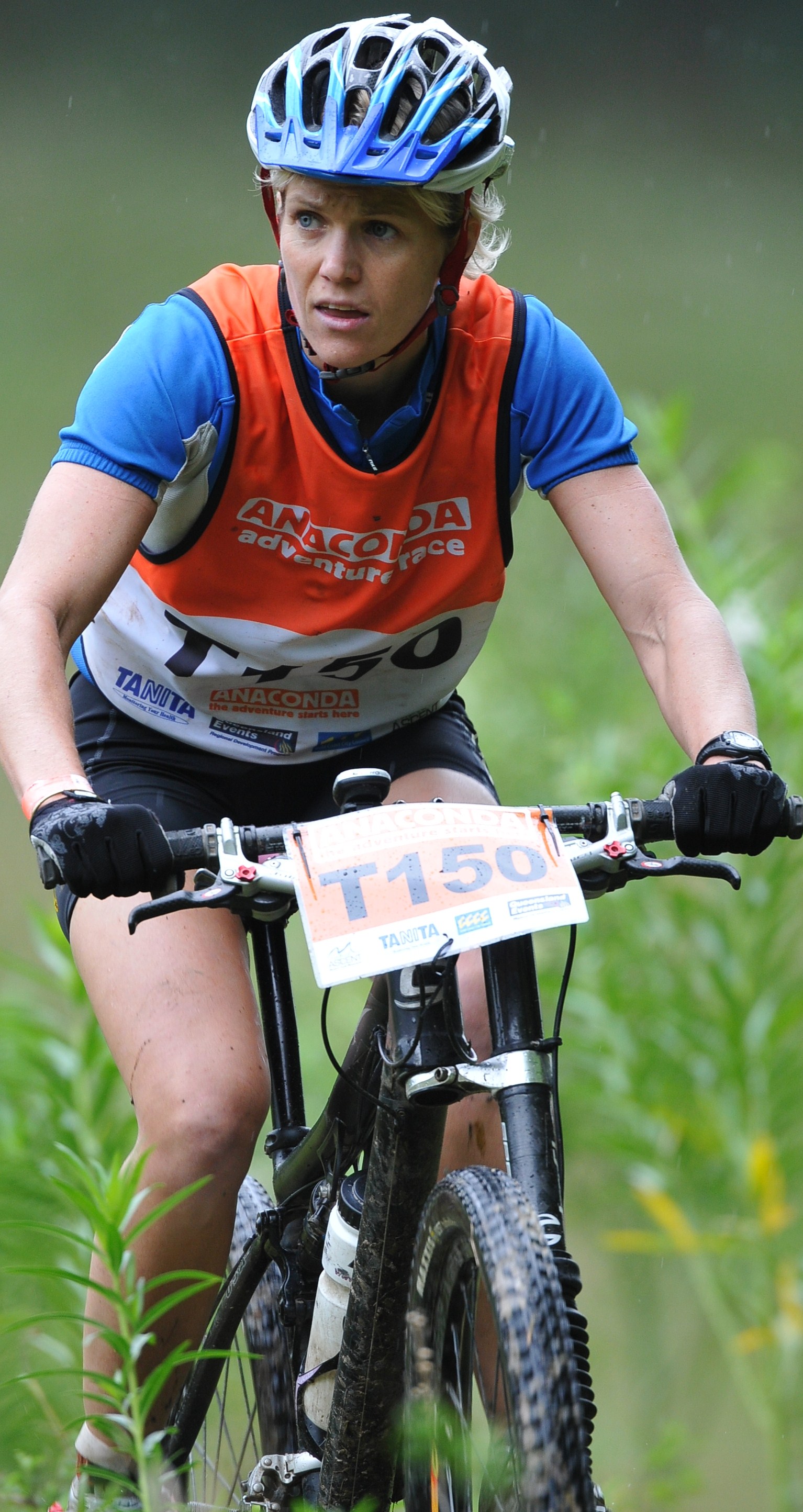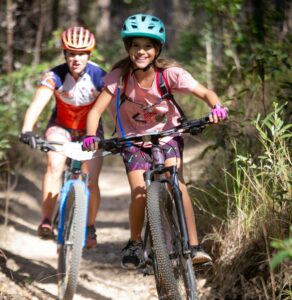Starting to Mountain Bike after being a road rider/triathlete seems like it should be a pretty easy cross-over right? On both bikes you just sit in the saddle, put your feet on the pedals and pedal in a circle while holding the handle bars right? So, how hard can it be to start Mountain Biking???
 Mountain biking and road riding actually require very different technique and skills. On a road bike, your aim is to sit on the seat and keep still and stable so that you can generate force from your hips and legs that transfer to the pedals to propel you forwards as fast as possible. You aim for the bike and rider to be stable.
Mountain biking and road riding actually require very different technique and skills. On a road bike, your aim is to sit on the seat and keep still and stable so that you can generate force from your hips and legs that transfer to the pedals to propel you forwards as fast as possible. You aim for the bike and rider to be stable.
On a mountain bike, you will need to allow the bike to move around underneath you. The aim is to keep your centre of mass stable over the centre of the bike, but you will always be moving up and down and in and out of the saddle adjusting to terrain and obstacles while trying to keep forwards momentum. It takes time to get comfortable with this movement and these adjustments, so the biggest tip I can give anyone coming from road riding to mountain biking is: expect mountain biking to be very different and be prepared to be persistent in learning a totally new skill!!
Top Tips to start cross-country Mountain Biking:
1. Buy/use a mountain bike that fits! The right size is essential for your skill development and a good bike shop should measure you up and guide you just as if you were buying a road bike
2. Set-up your mountain bike position essentially the same as your road position:
– consider dropping your saddle 5-15mm to start so it is easier for you to reach the ground and put your foot down
-keep your saddle in the same fore-aft position over your bottom bracket and set-up your cleats as close as possible to the same as your road cleats
-ideally use a pair of carbon-soled mtb shoes as this helps your force transfer to the pedals, but be aware that if you have any hike-a-bikes (ie. where you are walking/pushing your bike up a hill or through the mud), these shoes are harder to walk in than plastic-soled shoes and your feet may become uncomfortable if you have to do this for long periods (ie. when adventure racing)
-make sure your grips are not too thick (especially if you are a female with small hands). On a mountain bike you will need better grip than on the road and you need easy access to your brake levers
 3. Start mtb-ing in shoes and cleats. Although this thought may be a little more daunting than starting in jogger shoes without your feet fixed to the pedals, it is A LOT harder to learn correct skills. Having your feet fixed to the pedals by using cleats allows you to help maneuver the bike through your feet and improves this point as a base of support. Most mtb shoe and cleat systems are looser than road so it should be easier for you to clip-out. If it is stiff if anyway to clip out, adjust your pedals and check if you need to cut-away any rubber under the bottom of your shoe to allow your cleat to slide out of the pedal easier
3. Start mtb-ing in shoes and cleats. Although this thought may be a little more daunting than starting in jogger shoes without your feet fixed to the pedals, it is A LOT harder to learn correct skills. Having your feet fixed to the pedals by using cleats allows you to help maneuver the bike through your feet and improves this point as a base of support. Most mtb shoe and cleat systems are looser than road so it should be easier for you to clip-out. If it is stiff if anyway to clip out, adjust your pedals and check if you need to cut-away any rubber under the bottom of your shoe to allow your cleat to slide out of the pedal easier
4. Disc brakes are far, far superior to standard caliper brakes so try and find an mtb with disc brakes. If you do have disc brakes, ride with only 2 fingers on (or close to) your brake levers as disc brakes don’t require much pressure to slow you down fast
5. On a mtb your upper body strength and connection of your arms to your torso is far more important than on the road. This is essential for directing where you want the front of the bike to go, especially when cornering. Think about keeping your shoulders down and gently drawing your lats and shoulder-blades down and flat onto your trunk
6. Look ahead 2-5m to sight the line that you want to ride. This is especially important when cornering- always continue to look around the corner to keep your line
7. When riding up a steep hill, pull yourself forwards and sit on the very front tip of your seat to keep your front wheel down. When riding a steep downhill, move your bum towards the back of the seat- you may need to even drop your bum completely over the back of your saddle to prevent yourself going over the handlebars
8. Find a balance between speed and your level of skill. The faster you can ride over obstacles and through sand/mud/over rocks often makes it easier to negotiate these obstacles as your bike has momentum and it reduces slippage
9. When riding technical terrain, always go with at least 1 friend and take a phone that works so that if something were to happen you have access to help
10. Allow the bike to move underneath you. Its ok for your tyres to slip and slide just a little. Get comfortable with this feeling and gradually develop the confidence to know that your tyres are thicker and grippier than your road tyres and that just because your wheel slips doesn’t mean you are going to fall off
11. Finally: Be patient and be prepared to have a few stacks before you really feel the thrill and challenge of being a good mountain-biker
Where to Mountain Bike on the Gold Coast:
If you want a really easy start to mountain biking, try the sandy trails of The Spit.
For a nice ride with flowing tracks that provides more challenge than The Spit, head up to Daisy Hill (about 45min north of the Gold Coast). Daisy Hill has manicured and purpose-built tracks appropriate for various levels.
If you are happy to throw yourself in the deep-end, head to Nerang State Forest (entry at the Velodrome). Nerang is about as technical as it comes in regards to mountain biking and if you can ride here, you can ride anywhere. With all the single-track and fire roads, there is probably around 60km of riding to be done out there without going over the same track. But be aware: it is hilly and rocky, and you will encounter obstacles galore and some very technical and skinny bridges- but it can also be fun and challenging as anything!
Finally, the Border Track is a trail used in the Anaconda Adventure Race on the GC with the best point of access being at the top of Bains Road off Currumbin Valley (look on the opposite side of the fence toTomewin Mountain Rd). The track is hilly and relatively technical and only runs for 10-12km before you end up at the house line at Currumbin/Tugun and you need to find a way down off the track between houses.
There are some other great undefined and relatively unused tracks throughout the Hinterland. To ride these you really need to join a group who has been before and can roughly guide you (try contacting Nerang Mountain Bike Club). These rides are usually a great adventure but are challenging and for the fitter and more technically skilled riders.

































